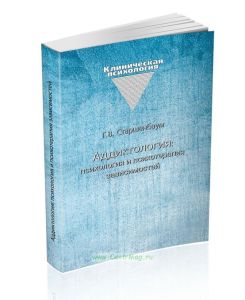- Артикул:00-01052351
- Автор: Ian E. Wickramasekera
- ISBN: 978-1-4757-9708-4
- Обложка: Твердая обложка
- Издательство: Springer-Science+Business Media (все книги издательства)
- Город: New York
- Страниц: 333
- Год: 1988
- Вес: 492 г
Clinical Behavioral Medicine. Some Concepts and Procedures/Клиническая поведенческая медицина. Некоторые концепции и процедуры
Книга на английском языке.
This book is an effort to integrate some clinical observations, theoretical concepts, and promising clinical procedures that relate psychological variables to physiological variables. My primary emphasis is on what psychological and behavioral concepts and procedures are most likely to enable us to influence physiological functions. The book covers questions that have fascinated me and with which I have struggled in daily clinical practice. What types of people are most at risk for physical disorders or dysfunctions? Why do some people present psychosocial conflicts somatically and others behaviorally? What is the placebo effect and how does it work? How do you arrange the conditions to alter maladaptive belief systems that contribute to psychopathology and pathophysiology? Do beliefs have biological consequences?
Contents
1. What Kinds of People Are at High Risk to Develop Chronic Stress-Related Symptoms?
Hypnotic Ability
High-Hypnotic Ability
Low-Hypnotic Ability
Habitual Catastrophizing (Panicking) Cognitions
Sympathetic Reactivity/Negative Affectivity (Neuroticism)
Major Life Changes and/or Daily Hassles
Major Life Change
Daily Hassles
Social Support Systems and Coping Skills
Social Support
Coping Skills
Discussion
Some Predictions from the Model
References
2. Clinical Behavioral Medicine and Its Cutting Edges: Biofeedback, Behavior Therapy, and Hypnosis
The Origins of Behavioral Medicine
Psychophysiological Stress Management Skills for Pain, Anxiety, and Sleep Disorders
Common Features of Biofeedback, Behavior Therapy, and Hypnosis
Roots in the Experimental Laboratory
Potentiating the Placebo Effect
Independent Variables
Quantitative Dependent Variables
Psychophysiological Focus
Self-Regulation
Wider Application
Procedural Handle on Cognition
References
3. Hypnosis: Scientific Status and Clinical Relevance
Current Theories of Hypnosis
Parameters of Hypnosis
Characteristics of High Hypnotizables
Psychopathology, Pathophysiology, Healing, and Hypnotic Ability
Increasing Hypnotic Ability
Summary of Clinical Implications
References
4. Crocks, Quacks, and Shrinks
Crocks and Quacks
Why Skills Taught by Psychotherapists May Be Promising Alternatives to Pills for Some Patients
References
5. What Is the Placebo Effect and How Does It Work?
The Placebo Effect
Theories of the Placebo
Origins of the Conditioned-Response Model
The Clinical Situation and Conditioning Phenomena
Unconditioned Stimuli
Conditioned Stimuli
The Placebo as a Conditioned Response
Components of the Conditioned Placebo Response
The Cognitive-Verbal Component
The Motor Component
The Physicochemical Component
Developmental Aspects of Conditioned Placebo Response
Historical Aspects
Acquisition Phase
Consolidation Phase
Placebo Responding
Health Deprivation, Anxiety, Dependency, the "Core Conditions," and Placebo Responding
Placebo Responding and Hypnotizability
Parameters of Placebo Learning
Phenomena of Conditioning
Predictions from the Model
Testing the Model
Conclusion
References
6. Initial Patient Interview
Why Patients Come to See Us
Priorities and Procedures
References
7. Psychophysiological Role Induction or the Trojan Horse Procedure
Psychophysiological Demonstrations
Educational Model
Co-Investigator
Out of the Closet-The Psychotherapy Candidate
Data on the Effects of the Psychophysiological Role Induction
References
8. The Diagnosis and Psychophysiological Management of Chronic Pain and Anxiety
Acute and Chronic Pain
Illness Behavior Syndrome and Chronic Pain
Theory of the Acquisition of Chronic Pain and Anxiety
Hypnotic Ability
Negative Affectivity
Catastrophizing
Rationales for the Use of Psychological and Behavioral Procedures with Pain
Hypnosis for Pain
Biofeedback for Pain
Behavior Modification for Pain
Clinical Guidelines for a Psychophysiological Approach to a Chronic Pain Patient
Role Induction for Chronic Pain Patients
Case Study of a Chronic Pain Patient
Summary and Conclusion
References
9. High-Risk Profile: Assessment, Patient Feedback, and Therapy Planning
Assessment Questions and Assumptions
Discussion of Assessment Questions
High-Hypnotic Ability
Low-Hypnotic Ability
High Catastrophizing (Panicking) Cognitions
Neuroticism (Negative Affectivity) and Excessive Sympathetic Reactivity
Major Life Changes
Hassles
Support Systems
Coping Skills
Therapy Planning
Case Study of a Low-Hypnotic-Ability Patient
Case Study of a High-Hypnotic-Ability Patient
References
10. Self-Hypnosis and the Common Components of Other Stress-Reduction Techniques: A Theory
Psychological Stress
Self-Hypnosis and the Alteration of the Perception of Stressors
Common Procedural Components
Common Therapeutic Mechanisms
Enhanced Hypnotizability
Allocentric Mode of Perception
Cognitive Control of Physiology
Sensory Restriction and Enhanced Hypnotizability
Muscle Relaxation and Enhanced Hypnotizability
Summary
References
Appendixes
A. Problems with Hypnosis and Crucial Clinical Concepts
B. Brief Procedures to Assess Hypnotic Ability and Attitude
C. Unobtrusive Procedures
Low Frontal EMG and Eyes Closed
EEG Alpha Density and Hypnotic Ability
The Conjugate Lateral Eye Movement Test
Experience Inventories
D. Wickram Experience Inventory
E. Wickram's Modification of the Spiegel Hypnotic Induction Procedures
F. Informal Clinical Testing for Hypnotic Ability with Test Suggestions
G. Subjective Response Inquiry
H. Wickramasekera' s Diagnostic Interview for Headache
I. Hypnotic Procedure to Reduce Headache Pain
J. In Vitro Desensitization (SO) Procedure
K. Background Questionnaire
L. Behavioral Medicine Clinic and Stress Disorders Research Laboratory: Statement of Procedures
M. Behavioral Medicine Clinic and Stress Disorders Research Laboratory: Assessment for Admission
N. Psychophysiological Profile
Selected Bibliography
Index
Рекомендуем




